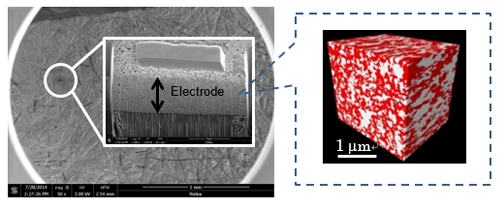Research
Our group has been working on “Fuel Cell Research for Vehicles”. We focus on development of novel electrocatalysts, which play a most important role for fuel cell performance. Electrocatalysts are generally made from platinum (Pt) nanoparticles deposited on carbon supports as seen in the image. We are trying to increase efficiency and durability of electrocatalysts for further developing FCVs, with following approaches.

Investigation of degradation mechanism of electrocatalysts by in-situ SEM/STEM
(Collaboration with Hitachi High Technologies Corporation)
We have captured a degradation phenomenon of Pt nanoparticles on carbon in real time by using specially designed Hitachi HF-3300 (Transmission Electron Microscope). The movie is taken for 30 min and played at 50x speed. The left and right images show the surface and transmitted images of Pt/carbon electrocatalyst, respectively. The phenomenon of Pt embedding into carbon is observed. Therefore, we have found that Pt embedding is one possible degradation mechanism of electrocatalysts.
Encapsulation of Pt into nano-channels to suppress its degradation

The aim of this study is to decrease the mobility of Pt particles on carbon using the curved surface of nano-channels of mesoporous carbon materials. We have succeeded to increase the reactivity and durability of electrocatlysts by encapsulating Pt nanoparticles into nano-channels to suppress Pt aggregation.
Graphitization of carbon surface to increase durability

Carbon oxidation is known as one degradation mechanism of electrocatalyts. Graphitization of carbon surface by heat-treatment is one possible way to increase tolerance to carbon oxidation. We have successfully increased durability against carbon corrosion with this method.
Investigation of electrode degradation at higher temperature operation
A possible approach to further increase the efficiency of FCVs is increasing the operating temperature above 100 oC. On the other hand, elevating operation temperature leads to increasing the rate of degradation. Based on such a background, the purpose of this study is to extract the problems through the operation of fuel cells at elevated temperature and then to design durable electrocatalysts at higher temperature. We are now working on constructing and understanding images of the electrode structure after degradation by using the focused ion beam-scanning electron microscope technique.

We are also working on hydrogen storage materials with Prof. Akiba and electrocatalysts for water electrolysis with Prof. Ito.
